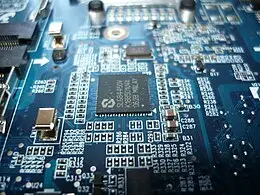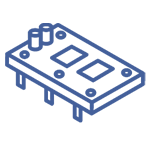Categories
- Clock Generators, PLLs, Frequency Synthesizers(16,370)
- 1
- 2
- 3
- 4
- 5
- 6
- 250
Description of Clock Generators, PLLs, Frequency Synthesizers
Clock generators, PLLs, and frequency synthesizer integrated circuits (ICs) provide a steady timing pulse from a reference signal for logic devices such as computers, microcontrollers, data communication systems, and graphic/video generators. These integrated circuits may include buffers, drivers, dividers, multipliers, multiplexers, synthesizers, fanout distributors, and prescalers.
Clock generators, PLLs (Phase-Locked Loops), and frequency synthesizers are essential components in modern electronics, particularly in timing and synchronization of signals across digital and analog systems. Here's an overview of each:
Clock Generators
Clock generators provide a stable, periodic clock signal used to synchronize the operation of digital systems, such as processors, memory, and communication circuits. They are critical in ensuring that all parts of the system work in unison. The clock generator typically consists of a crystal oscillator or another timing source, which generates the fundamental clock frequency. These circuits are commonly found in computers, microcontrollers, and communication devices.

Key characteristics of clock generators
Accuracy and Stability: Often derived from a crystal or other high-precision oscillator.
Frequency Range: Can generate a variety of frequencies to match the system’s needs.
Low Jitter: Jitter refers to small, rapid variations in the clock signal, and low jitter is essential for maintaining reliable timing.
Phase-Locked Loops (PLLs)
A PLL is a control system that synchronizes an output signal with a reference signal in terms of phase and frequency. It is a feedback system that compares the phase of the input signal to the output signal and adjusts the output frequency to match the input.
Main Components:
Phase Detector: Compares the input (reference) signal with the output signal.
Low-Pass Filter: Filters out high-frequency noise from the phase detector output.
Voltage-Controlled Oscillator (VCO): Generates an output frequency that is adjusted based on the control voltage from the phase detector.
Feedback Loop: Feeds the output signal back to the phase detector for continuous comparison.
Applications:
Clock Recovery: In communication systems, to recover timing information from data streams.
Frequency Synthesis: Used in synthesizing frequencies from a stable reference.
Signal Demodulation: In radio receivers to demodulate phase-modulated signals.
3. Frequency Synthesizers
A frequency synthesizer generates a range of frequencies from a single reference frequency, typically using a PLL. It allows for precise frequency control, often programmable, making it crucial in modern communication systems and signal processing applications.
Types:
Direct Digital Synthesizers (DDS): Use digital processing techniques to generate a frequency by numerically controlling the phase of the signal.
PLL-Based Synthesizers: Utilize a PLL circuit to produce a wide range of frequencies by multiplying or dividing the reference signal.
Applications:
Telecommunications: For generating carrier frequencies in modems, radios, and cellular networks.
Signal Processing: Used in test equipment to generate specific frequencies for measurement and analysis.
RF Applications: Essential in radio frequency (RF) circuits to produce precise frequencies for transmitters and receivers.
Summary
Clock Generators provide a stable clock signal to synchronize systems.
PLLs synchronize an output signal’s phase and frequency to a reference.
Frequency Synthesizers produce a range of frequencies from a single reference, often using PLLs.
These components are vital for ensuring accurate timing, frequency control, and synchronization in electronic systems.







